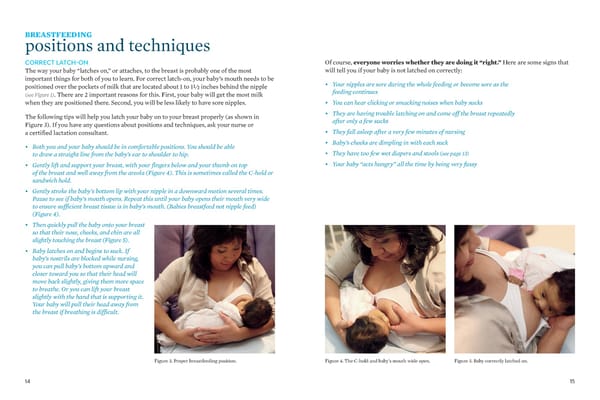BREASTFEEDING positions and techniques CORRECT LATCH-ON Of course, everyone worries whether they are doing it “right.” Here are some signs that The way your baby “latches on,” or attaches, to the breast is probably one of the most will tell you if your baby is not latched on correctly: important things for both of you to learn. For correct latch-on, your baby’s mouth needs to be • Your nipples are sore during the whole feeding or become sore as the positioned over the pockets of milk that are located about 1 to 1½ inches behind the nipple feeding continues (see Figure 1). There are 2 important reasons for this. First, your baby will get the most milk when they are positioned there. Second, you will be less likely to have sore nipples. • You can hear clicking or smacking noises when baby sucks The following tips will help you latch your baby on to your breast properly (as shown in • They are having trouble latching on and come off the breast repeatedly Figure 3). If you have any questions about positions and techniques, ask your nurse or after only a few sucks a certified lactation consultant. • They fall asleep after a very few minutes of nursing • Both you and your baby should be in comfortable positions. You should be able • Baby’s cheeks are dimpling in with each suck to draw a straight line from the baby’s ear to shoulder to hip. • They have too few wet diapers and stools (see page 13) • Gently lift and support your breast, with your fingers below and your thumb on top • Your baby “acts hungry” all the time by being very fussy of the breast and well away from the areola (Figure 4). This is sometimes called the C-hold or sandwich hold. • Gently stroke the baby’s bottom lip with your nipple in a downward motion several times. Pause to see if baby’s mouth opens. Repeat this until your baby opens their mouth very wide to ensure sufficient breast tissue is in baby’s mouth. (Babies breastfeed not nipple feed) (Figure 4). • Then quickly pull the baby onto your breast so that their nose, cheeks, and chin are all slightly touching the breast (Figure 5). • Baby latches on and begins to suck. If baby’s nostrils are blocked while nursing, you can pull baby’s bottom upward and closer toward you so that their head will move back slightly, giving them more space to breathe. Or you can lift your breast slightly with the hand that is supporting it. Your baby will pull their head away from the breast if breathing is difficult. Figure 3. Proper breastfeeding position. Figure 4. The C-hold and baby’s mouth wide open. Figure 5. Baby correctly latched on. 14 15
 Breastfeeding Guide Page 7 Page 9
Breastfeeding Guide Page 7 Page 9